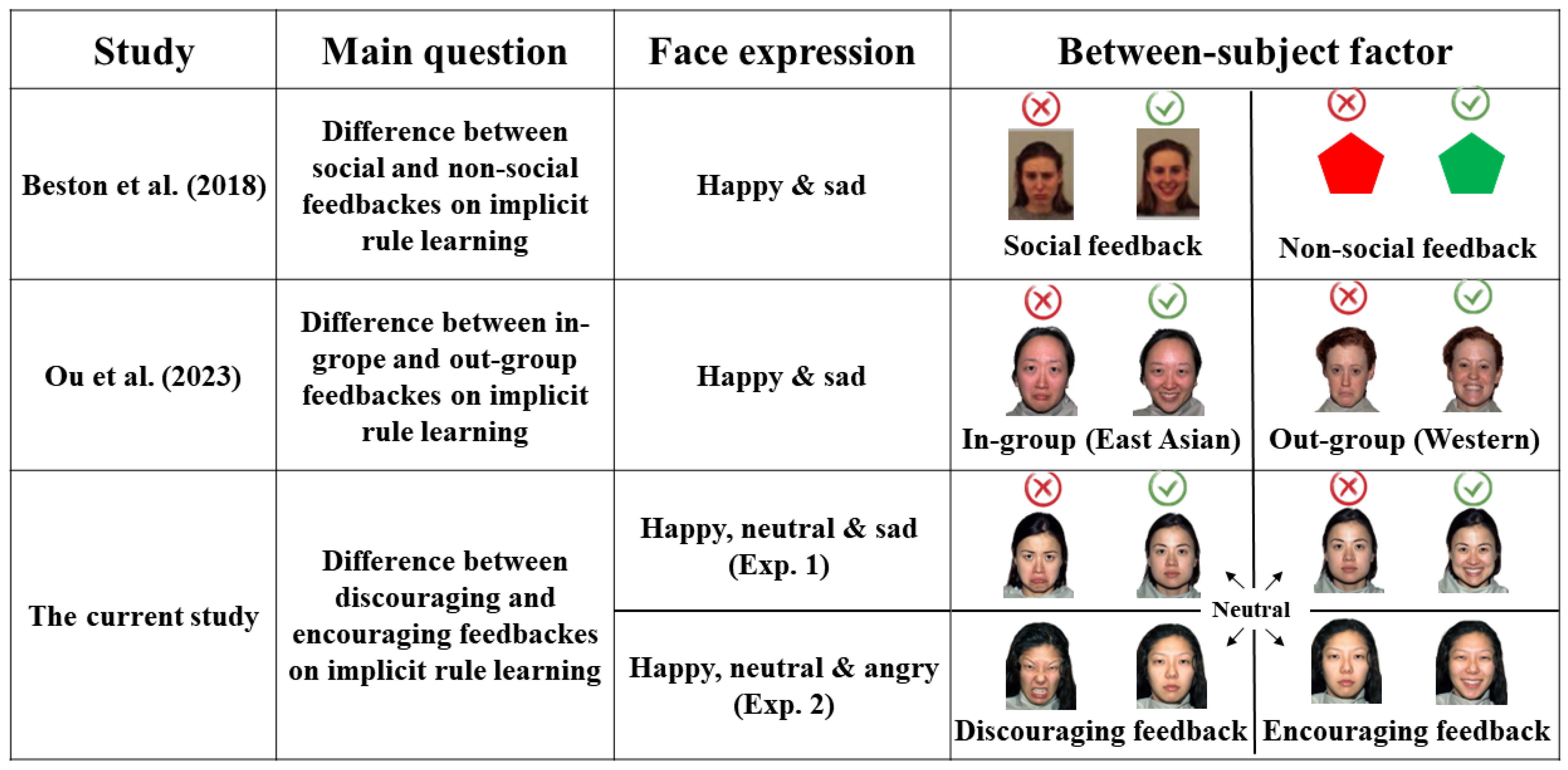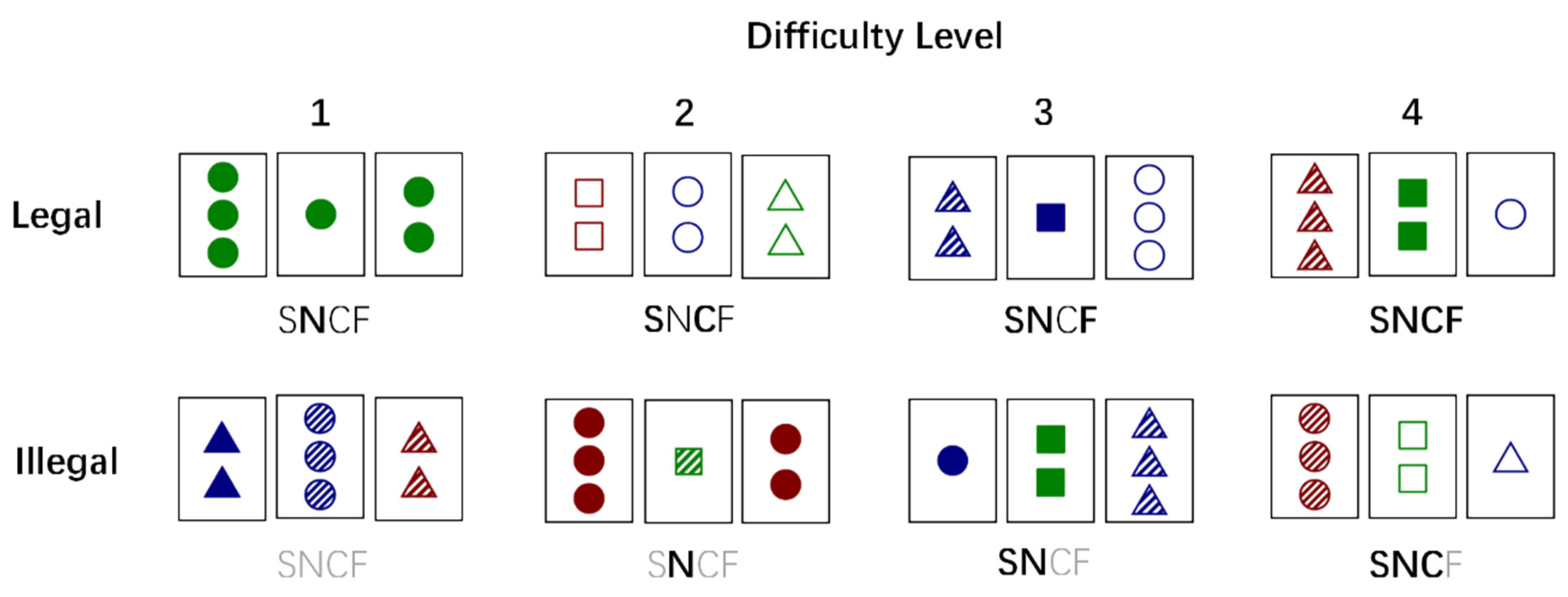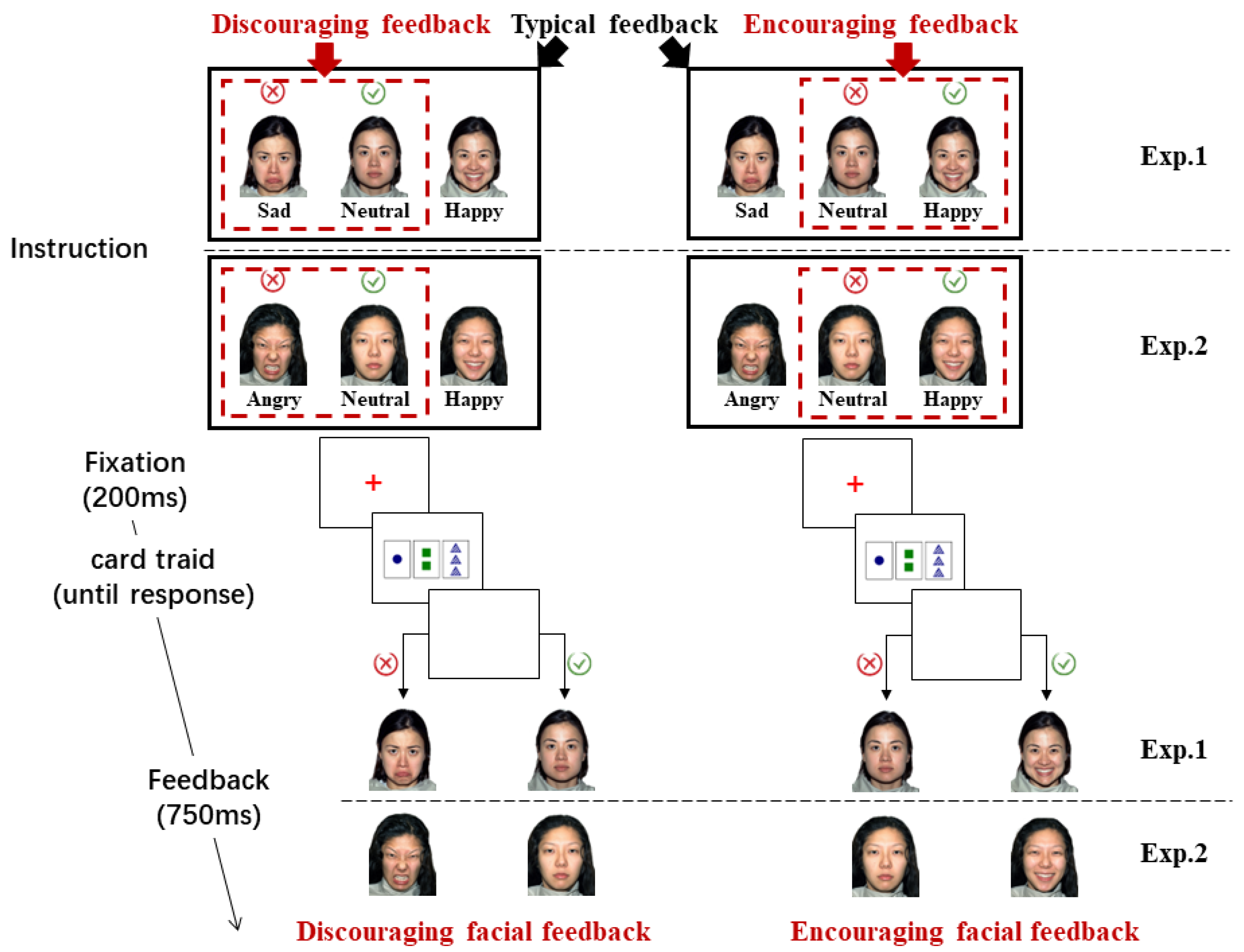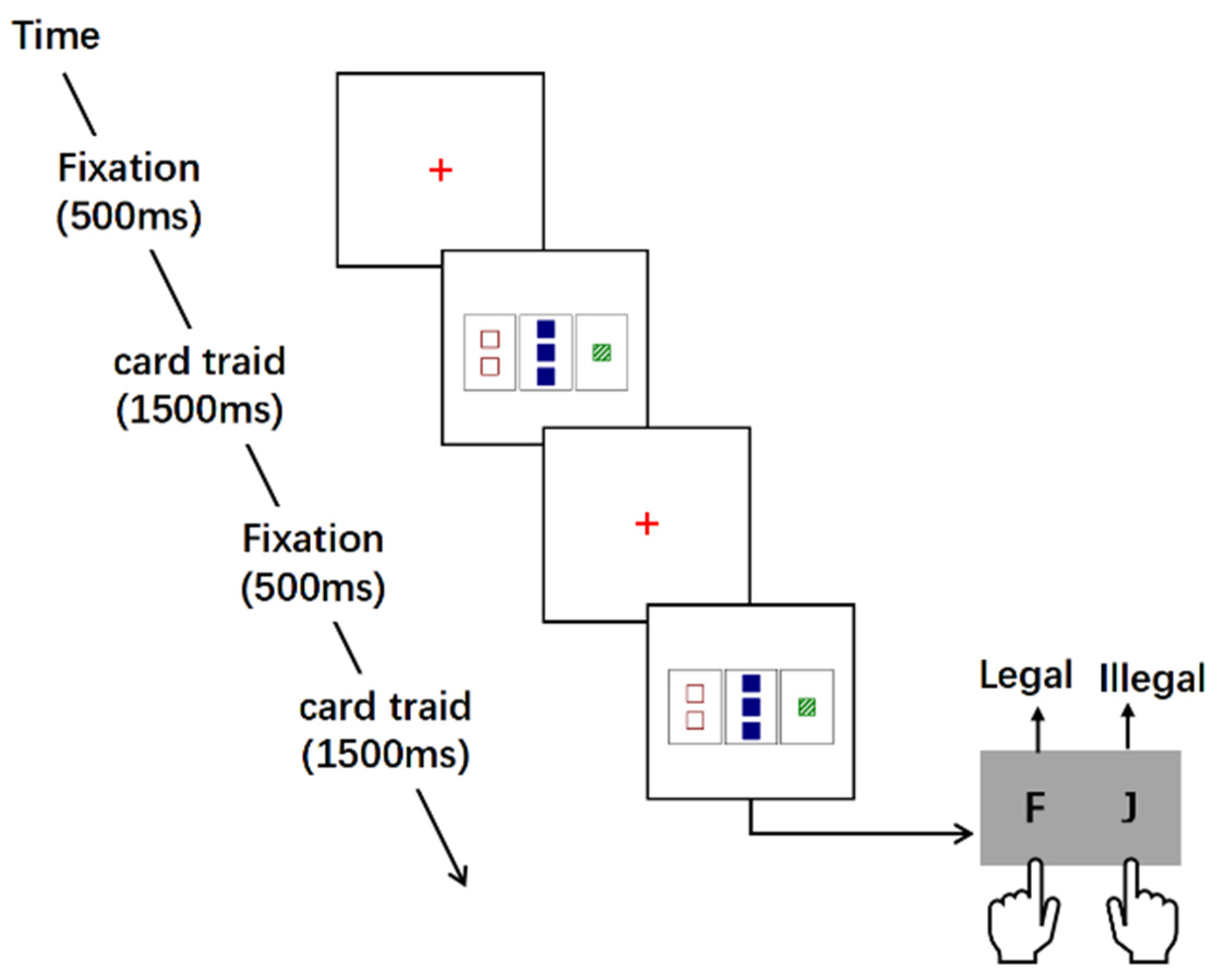By Carrot or by Stick: The Influence of Encouraging and Discouraging Facial Feedback on Implicit Rule Learning
Abstract
1. Introduction
1.1. Implicit Learning
1.2. The Social Feedback on Implicit Learning
1.3. Carrot and Stick: Encouraging and Discouraging Social Feedback
1.4. The Current Study: Aims and Hypotheses
2. Methods
2.1. Participants
2.2. Stimuli and Materials
2.2.1. Stimuli
2.2.2. Feedback
2.3. Procedures
2.3.1. Procedure of Experiment 1
2.3.2. Aim and Procedure of Experiment 2
2.4. Data Analysis
3. Results
3.1. Results of Experiment 1
3.1.1. Learning Phase of Exp. 1
3.1.2. Testing Phase of Exp. 1
3.2. Results of Experiment 2
3.2.1. Learning Phase of Exp. 2
3.2.2. Testing Phase of Exp. 2
4. Discussion
4.1. The Relationship with Previous Related Studies
4.2. Ecological Validity: The Sad-to-Angry Shift in Discouraging Facial Feedback from Exp. 1 to Exp. 2
4.3. Encouraging and Discouraging Feedback in Relation to Positive and Negative Reinforcement on Neo-Behaviorism
4.4. Limitations and Future Directions
4.5. Practical Implications
5. Conclusions
Author Contributions
Funding
Institutional Review Board Statement
Informed Consent Statement
Data Availability Statement
Acknowledgments
Conflicts of Interest
References
- Reber, A.S. Implicit learning of artificial grammars. J. Verbal Learn. Verbal Behav. 1967, 6, 855–863. [Google Scholar] [CrossRef]
- Seger, C.A. Implicit learning. Psychol. Bull. 1994, 115, 163–196. [Google Scholar] [CrossRef]
- Kihlstrom, J.F. The cognitive unconscious. Science 1987, 237, 1445–1452. [Google Scholar] [CrossRef]
- Frensch, P.A.; Rünger, D. Implicit learning. Curr. Dir. Psychol. Sci. 2003, 12, 13–18. [Google Scholar] [CrossRef]
- Lewicki, P.; Hill, T.; Sasaki, I. Self-perpetuating development of encoding biases. J. Exp. Psychol. Gen. 1989, 118, 323–337. [Google Scholar] [CrossRef]
- Neal, A.; Hesketh, B. Episodic knowledge and implicit learning. Psychon. Bull. Rev. 1997, 4, 24–37. [Google Scholar] [CrossRef]
- Reber, A.S. Implicit learning and tacit knowledge. J. Exp. Psychol. Gen. 1989, 118, 219–235. [Google Scholar] [CrossRef]
- Dienes, Z.; Altmann, G.T.M.; Kwan, L.; Goode, A. Unconscious knowledge of artificial grammars is applied strategically. J. Exp. Psychol.-Learn. Mem. Cogn. 1995, 21, 1322–1338. [Google Scholar] [CrossRef]
- Posner, M.I.; Keele, S.W. On the genesis of abstract ideas. J. Exp. Psychol. 1968, 77, 353–363. [Google Scholar] [CrossRef]
- Dienes, Z.; Altmann, G.T.M.; Gao, S.-J. Mapping across domains without feedback: A neural network model of transfer of implicit knowledge. Cogn. Sci. 1999, 23, 53–82. [Google Scholar] [CrossRef]
- Servan-Schreiber, E.; Anderson, J.R. Learning artificial grammars with competitive chunking. J. Exp. Psychol.-Learn. Mem. Cogn. 1990, 16, 592–608. [Google Scholar] [CrossRef]
- Berry, D.C.; Broadbent, D.E. On the relationship between task performance and associated verbalizable knowledge. Q. J. Exp. Psychol. A 1984, 36, 209–231. [Google Scholar] [CrossRef]
- Pothos, E.M.; Bailey, T.M. The role of similarity in artificial grammar learning. J. Exp. Psychol.-Learn. Mem. Cogn. 2000, 26, 847–862. [Google Scholar] [CrossRef] [PubMed]
- Kulhavy, R.W. Feedback in written instruction. Rev. Educ. Res. 1977, 47, 211–232. [Google Scholar] [CrossRef]
- Moreno, R. Decreasing cognitive load for novice students: Effects of explanatory versus corrective feedback in discovery-based multimedia. Instr. Sci. 2004, 32, 99–113. [Google Scholar] [CrossRef]
- Butler, D.L.; Winne, P.H. Feedback and self-regulated learning: A theoretical synthesis. Rev. Educ. Res. 1995, 65, 245–281. [Google Scholar] [CrossRef]
- Hurlemann, R.; Patin, A.; Onur, O.A.; Cohen, M.X.; Baumgartner, T.; Metzler, S.; Dziobek, I.; Gallinat, J.; Wagner, M.; Maier, W.; et al. Oxytocin Enhances amygdala-dependent, socially reinforced learning and emotional empathy in humans. J. Neurosci. 2010, 30, 4999–5007. [Google Scholar] [CrossRef]
- Hu, J.; Qi, S.; Becker, B.; Luo, L.; Gao, S.; Gong, Q.; Hurlemann, R.; Kendrick, K.M. Oxytocin selectively facilitates learning with social feedback and increases activity and functional connectivity in emotional memory and reward processing regions. Hum. Brain Mapp. 2015, 36, 2132–2146. [Google Scholar] [CrossRef]
- Beston, P.J.; Barbet, C.; Heerey, E.A.; Thierry, G. Social feedback interferes with implicit rule learning: Evidence from event-related brain potentials. Cogn. Affect. Behav. Neurosci. 2018, 18, 1248–1258. [Google Scholar] [CrossRef]
- Legaz, A.; Abrevaya, S.; Dottori, M.; González Campo, C.; Birba, A.; Martorell Caro, M.; Aguirre, J.; Slachevsky, A.; Aranguiz, R.; Serrano, C.; et al. Multimodal mechanisms of human socially reinforced learning across neurodegenerative diseases. Brain 2022, 145, 1052–1068. [Google Scholar] [CrossRef]
- Sobczak, A.; Bunzeck, N. Effects of positive and negative social feedback on motivation, evaluative learning, and socio-emotional processing. npj Sci. Learn. 2023, 8, 28. [Google Scholar] [CrossRef] [PubMed]
- Ou, M.; Peng, W.; Zhang, W.; Ouyang, M.; Liu, Y.; Lu, K.; Zeng, X.; Yuan, J. The role of in-group and out-group facial feedback in implicit rule learning. Behav. Sci. 2023, 13, 963. [Google Scholar] [CrossRef] [PubMed]
- Frank, M.J.; Seeberger, L.C.; O’Reilly, R.C. By carrot or by stick: Cognitive reinforcement learning in Parkinsonism. Science 2004, 306, 1940–1943. [Google Scholar] [CrossRef] [PubMed]
- Chang, H.F. Carrots, sticks, and international externalities. Int. Rev. Law Econ. 1997, 17, 309–324. [Google Scholar] [CrossRef]
- Arena, C.; Liong, R.; Vourvachis, P. Carrot or stick: CSR disclosures by Southeast Asian companies. Sustain. Account. Manag. Policy J. 2018, 9, 422–454. [Google Scholar] [CrossRef]
- Tannenbaum, D.; Valasek, C.J.; Knowles, E.D.; Ditto, P.H. Incentivizing wellness in the workplace: Sticks (not carrots) send stigmatizing signals. Psychol. Sci. 2013, 24, 1512–1522. [Google Scholar] [CrossRef] [PubMed]
- Eskreis-Winkler, L.; Fishbach, A. Not learning from failure—The greatest failure of all. Psychol. Sci. 2019, 30, 1733–1744. [Google Scholar] [CrossRef]
- Goeleven, E.; De Raedt, R.; Leyman, L.; Verschuere, B. The Karolinska directed emotional faces: A validation study. Cogn. Emot. 2008, 22, 1094–1118. [Google Scholar] [CrossRef]
- Lundqvist, D.; Flykt, A.; Öhman, A. Karolinska directed emotional faces. PsycTESTS Dataset 1998, 91, 630. [Google Scholar] [CrossRef]
- Tottenham, N.; Tanaka, J.W.; Leon, A.C.; McCarry, T.; Nurse, M.; Hare, T.A.; Marcus, D.J.; Westerlund, A.; Casey, B.; Nelson, C. The NimStim set of facial expressions: Judgments from untrained research participants. Psychiatry Res. 2009, 168, 242–249. [Google Scholar] [CrossRef]
- Zhang, Z.; Carlisle, N.B. Explicit attentional goals unlock implicit spatial statistical learning. J. Exp. Psychol. Gen. 2023, 152, 2125–2137. [Google Scholar] [CrossRef] [PubMed]
- Veerapa, E.; Grandgenevre, P.; El Fayoumi, M.; Vinnac, B.; Haelewyn, O.; Szaffarczyk, S.; Vaiva, G.; D’Hondt, F. Attentional bias towards negative stimuli in healthy individuals and the effects of trait anxiety. Sci. Rep. 2020, 10, 11826. [Google Scholar] [CrossRef] [PubMed]
- Locke, E.A.; Latham, G.P. Building a practically useful theory of goal setting and task motivation: A 35-year odyssey. Am. Psychol. 2002, 57, 705–717. [Google Scholar] [CrossRef] [PubMed]
- Angulo-Barroso, R.M.; Peciña, S.; Lin, X.; Li, M.; Sturza, J.; Shao, J.; Lozoff, B. Implicit learning and emotional responses in nine-month-old infants. Cogn. Emot. 2017, 31, 1031–1040. [Google Scholar] [CrossRef]
- Powell, J.; Hake, D.F. Positive vs. negative reinforcement: A direct comparison of effects on a complex human response. Psychol. Rec. 1971, 21, 191–205. [Google Scholar] [CrossRef]
- Susilo, T.; Germine, L.; Duchaine, B. Face recognition ability matures late: Evidence From individual differences in young adults. J. Exp. Psychol. Hum. Percept. Perform. 2013, 39, 1212–1217. [Google Scholar] [CrossRef]





Disclaimer/Publisher’s Note: The statements, opinions and data contained in all publications are solely those of the individual author(s) and contributor(s) and not of MDPI and/or the editor(s). MDPI and/or the editor(s) disclaim responsibility for any injury to people or property resulting from any ideas, methods, instructions or products referred to in the content. |
© 2024 by the authors. Licensee MDPI, Basel, Switzerland. This article is an open access article distributed under the terms and conditions of the Creative Commons Attribution (CC BY) license (https://creativecommons.org/licenses/by/4.0/).
Share and Cite
Liu, Y.; Ouyang, M.; Peng, W.; Zhang, W.; Lu, K.; He, Y.; Zeng, X.; Yuan, J. By Carrot or by Stick: The Influence of Encouraging and Discouraging Facial Feedback on Implicit Rule Learning. Behav. Sci. 2024, 14, 36. https://doi.org/10.3390/bs14010036
Liu Y, Ouyang M, Peng W, Zhang W, Lu K, He Y, Zeng X, Yuan J. By Carrot or by Stick: The Influence of Encouraging and Discouraging Facial Feedback on Implicit Rule Learning. Behavioral Sciences. 2024; 14(1):36. https://doi.org/10.3390/bs14010036
Chicago/Turabian StyleLiu, Yiling, Muxin Ouyang, Wenjie Peng, Wenyang Zhang, Keming Lu, Yujun He, Xiangyan Zeng, and Jie Yuan. 2024. "By Carrot or by Stick: The Influence of Encouraging and Discouraging Facial Feedback on Implicit Rule Learning" Behavioral Sciences 14, no. 1: 36. https://doi.org/10.3390/bs14010036
APA StyleLiu, Y., Ouyang, M., Peng, W., Zhang, W., Lu, K., He, Y., Zeng, X., & Yuan, J. (2024). By Carrot or by Stick: The Influence of Encouraging and Discouraging Facial Feedback on Implicit Rule Learning. Behavioral Sciences, 14(1), 36. https://doi.org/10.3390/bs14010036





